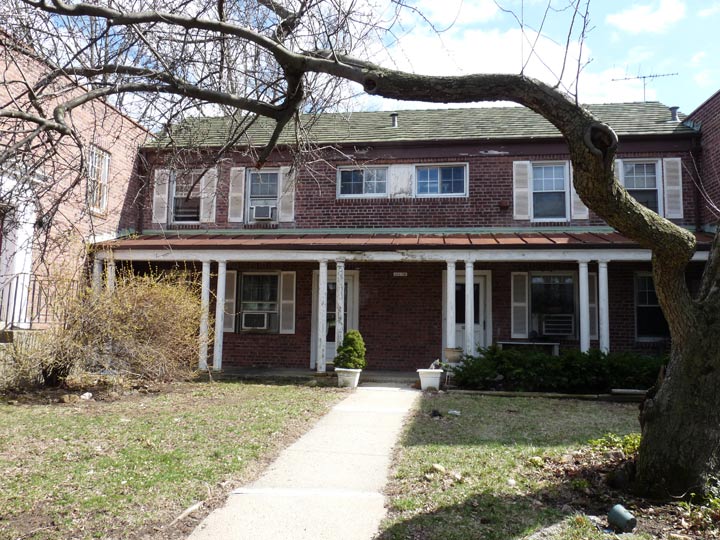About 13 years ago, when I was looking around for a new place in Queens after 14 years on the Flushing-Auburndale border, I took a look at Parkway Village, which sits at the south end of Kew Gardens Hills and the west end of Hillcrest, on an uneven plot defined by Union Turnpike, Grand Central Parkway, Main Street and just west of Parsons Boulevard.
Parkway Village is one of the oldest garden apartment complexes in New York City; it certainly wouldn’t be the last. It was founded in 1946 to house employees of the United Nations, whose headquarters were first located at what is today’s Queens Museum in Flushing Meadows and then in Lake Success, just over the city line and easily accessible via the Grand Central Parkway. The UN had, at first, tried leasing apartments in Peter Cooper Village and Fresh Meadows; however, those complexes were still discriminating against applicants on the basis of race, which beside moral considerations would be frankly impractical for an organization like the UN.

Thus Parkway Village became one of the first truly racially integrated communities in New York City. The policy continued after Parkway Village ended its association with the UN after its move to its Turtle Bay, Manhattan, headquarters in 1952. Among Parkway Village’s early residents was Nobel Peace Prize winner Ralph Bunche; civil rights leader Roy Wilkins and feminist author Betty Friedan were also residents.
Architect Leonard Schultze’s two-story brick buildings in a Colonial or Georgian style set the tone for the many garden apartment complexes that followed. Earlier, Schultze had designed the former luxury hotel Waldorf-Astoria at Lexington Avenue and East 49th Street. Parkway Village has not been designated by the Landmarks Preservation Commission, but they are in the National Register of Historic Places.
I don’t drive and so Parkway Village would be far away from where I was working in Port Washington at the time, so I ultimately settled on Westmoreland Gardens in Little Neck where I remain today, satisfied for the most part.
Check out the ForgottenBook, take a look at the gift shop, and as always, “comment…as you see fit.”
7/23/20


9 comments
Parkway Village is also one of the more acceptable projects associated with Robert Moses. As the NYC Coordinator of Construction, Moses was able to steer the UN’s selection committee straight into Manhattan. Wikipedia excerpt follows: “The landscape designer was Clarence Combs (1892-1958), who had previously worked on many other projects associated with Robert Moses, including the well-known Jones Beach State Park. Moses, a politically powerful parks commissioner and the driving force behind the construction of Parkway Village, had helped to arrange the project’s financing and lease with the UN. He likely recommended Combs for the landscaping role.”
There was a big Asbestos sandal at Parkway back in the 90’s when it was discovered that when the contractor removed the asbestos insulation from the underground heat pipes,it was not removed from the site but buried onsite. The value of the apartments plummeted with many banks calling mortgages.
My family moved from Astoria to Parkway Village in 1957. We Lived there until 1964. It was not like other parts of Queens in that it was very diverse due to the UN influence. I remember some of the famous people you mention and more. Ed Kranepool was a rookie with the Mets. Lines of mostly kid’s lined up at his apartment to get his autograph. I read about the asbestos. It was used to wrap all the heat pipes running under the buildings. Apartments were heated at first by a power house located within the complex. The land became very valuable as high rise buildings emerged all around. Haven’t been back for decades. Appreciate the post.
I remember it well. That big asbestos sandal was visible for miles!
I grew up in Kew Gardens Hills very close to Parkway Village. Until not long ago, there was a long line of private vehicle garages lining the eastbound side of Union Turnpike between Main Street and 149th Street. I always assumed these were garages for Parkway Village residents. They were all demolished and a line of three family homes stands on the space now.
The years I lived in Parkway Village 1957-1964 we had one of these garages. Tenants could pay an extra fee for one. My father used it for business storage. There were only link fences between each space on the other side of the doors. Not very secure. Surprised they were not demolished sooner.
There was also an area left undeveloped as part of the original Village plan called the “Green Field” along Parsons Blvd, SE Edge of Parkway Village. It too has since been developed with housing.
Those three family homes on Union Turnpike are dormitories for law students (of which I am one) at nearby St. John’s University. I always wondered why this development seems to take a bite out of Parkway Village.
For historic photos and plans of Parkway Village, visit Columbia University’s Digital Library Collection.
I babysat for a couple at Psrkway Village in the early 60s. The couple was very hip. Don’t remember their names or what she did but he was a jazz horn player. They had parties when they asked me to stay upstairs with their two kids, a boy and a girl. I remember sneaking on the stairs and seeing sex parties. The husband drove me home one night and parked and put his hands on me. I was maybe 16. Ten or so years later I read that the daughter has been abducted which broke my heart and I don’t know if she was ever recovered. Anyone have any recollection of this?